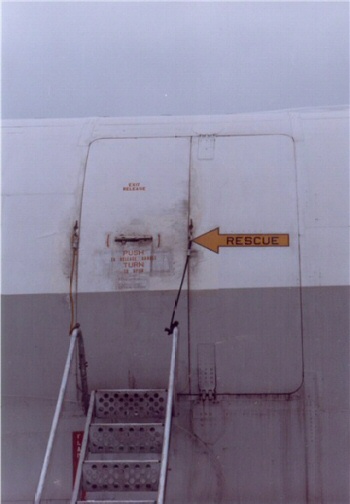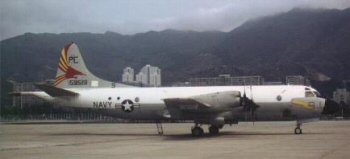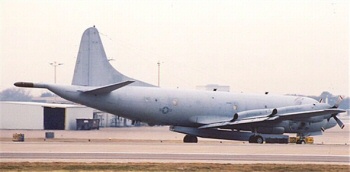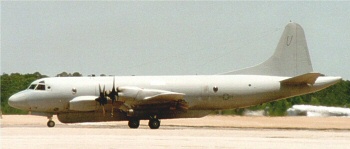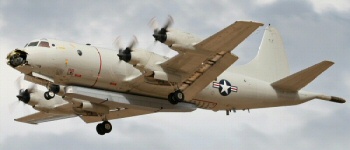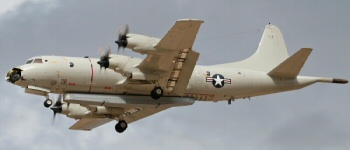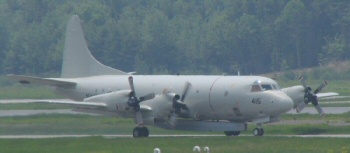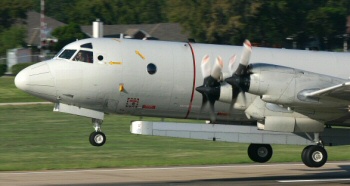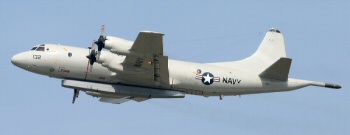P-3 Orion Research Group
The Netherlands
this page was last updated on 27 January 2013
P-3 Orion Sneaky Operations
CIA’s black P-3 program
A small number of American Orions has always been involved in operations which cannot tolerate daylight. Between 1964 and 1967 three P-3As were assigned to the "PROJ AF" what probably stands for "Project Air Force". The Orions involved (BuNos 149669, 149673 and 149678) were modified by Lockheed and E-Systems for a clandestine "reconnaissance project" in June 1964. External modifications included extended exhaust pipes on the nacelles (to reduce heat radiation), shortened propeller blades (to reduce the noise), a bulged observation window on top of the fuselage, panel and blade antennas, an air intake device in the position of the forward starboard observation window, and a cargo door (created by adding a "mirror" door to the existing entrance door). Furthermore the MAD boom had been removed and all three aircraft were painted black. Mission equipment included a Side Looking Airborne Radar (SLAR), special communications systems and infra red detection systems. For self protection the aircraft were fitted with Sidewinder missiles and one of them even is believed to have shot down a MiG fighter. The area of interest for these Orions was communist China. They were flying signal intelligence mission along the Chinese border but also were conducting missions over the South Chinese Sea, Burma, Tibet and clandestine overland missions over China. The black Orions have also been involved in missions over Vietnam, flying at night out of Okinawa, Japan. In May and July 1966 at least two of these black Orions were handed over to the Republic of China Air Force which operated them for a short period in support of a CIA program. (for further see “operators” section).
Special Projects Patrol Squadrons
Other "undercover" Orions are the specially equipped aircraft of the Special Projects Patrol Squadrons ONE and TWO (VPU-1 and VPU-2). Like the black P-3 program their operations started in the sixties. VPU-1 started as a Special Projects Detachment of VP-8 in 1969 under a project known as "Safire". This detachment was transferred to VP-26 in 1975 and became a permanent detachment in 1979. On 1 July 1982 VPU-1 was officially established at NAS Brunswick and it got the status of a full command on 1 March 1996. A similar unit started as a Special Projects detachment of VP-4 in 1969, became a permanent detachment on 15 November 1979 and was established as VPU-2 at NAS Barbers Point on 16 July 1982. It reached the status of an independent squadron on 27 March 1979. While the nature of VPU missions remains to be unclear, it is a fact that the squadrons always have operated their Orions under false identities, making them look like regular VP Orions. Many mistakes were made: sometimes P-3s were flying around with BuNos not even belonging to a P-3 and occasionally Orions which had crashed suddenly were seen flying again! Early VPU Orions could easily be recognized by the square optical window just behind the flight deck on the left hand side of the fuselage and by the camera bulge below the nose radome. The aircraft usually were fitted with a number of extra aerials below the rear fuselage. When the majority of Patrol Squadrons had transitioned to P-3C Orions and VPU-1 and VPU-2 were still operating P-3B airframes it was not unusual to see P-3Bs flying around with P-3C BuNos, fake squadron markings and black areas, which were meant to look like windows and sonobuoy launch tubes, painted on the fuselage. At Baldur Sveinsson’s website a number of interesting photos of VPU birds can be viewed (VPU-1´s specially equipped P-3Bs at NAS Keflavik)
The VPU mission birds, originally P-3A, later on P-3B and nowadays also P-3C Orions, are changing their identities all the time to hide amongst the aircraft of a regular P-3 squadron on deployment. VPU Orions are extensively modified for their special tasks. These modifications are initiated under a special programme the name of which changes every now and then. So far "Reef Point", "Storm Jib" and most recently "Iron Clad" are known to have been names for the classified programme. Special equipment onboard of the "Iron Clad" planes is believed to include communication systems, long range electro optical cameras, a "Pioneer" system for real time transmission of EOS-images, infra-red and chemical sensors and other intelligence systems. Official USN publications have referred to the VPU aircraft as "cousins of the EP-3E ARIES II". The difference with the EP-3E is that the aircraft of the Special Projects Patrol Squadrons hardly have any external characteristics to identify them as intelligence gathering aircraft. This makes the aircraft a valuable and interesting platform for "sneaky" operations. RAF Mildenhall, RAF Lakenheath and NAS Sigonella are frequently visited by VPU Orions transiting to and from NAS Brunswick, home station for VPU-1 "Old Buzzards". VPU-2 "Wizards" has its home base at MCAS Kaneohe Bay. Both squadrons operate at least two specially equipped Orions (VPU-1 is transitioning from P-3Bs to P-3Cs in 2001, while VPU-2 has two P-3Cs), augmented by one or two regular P-3Cs for utility and support duties. During the Gulf War both Special Projects Patrol Squadrons supported the allied forces with real time battle damage assessment images.
An interesting story by David A. Fulghum, describing the VPU squadrons, their aircraft and their missions, was published in the 8 March 1999 issue of "Aviation Week & Space Technology" (page 32).:
The opening paragraph reads: "For well over a decade, the U.S. Navy has been operating two small squadrons of what appear to be innocuous P-3 patrol aircraft but in fact are state-of-the-art sentinels packed with a multitude of classified sensors." Highlights of the article include: The squadrons involved are designated VPU-1 (the Old Buzzards) based in Brunswick, Maine, and VPU-2 (the Wizards) based at Barbers Point Hawaii. Both squadrons operate a stripped UP-3A aircraft for logistical and training use. The former operates (E)P-3Bs and the latter operates (E)P-3Cs. These aircraft carry the "most sophisticated optical, electronic, infared and chemical reconnaissance equipment," probably installed at facilities in Garland and Greenville, Texas formerly operated by E-Systems, now operated by Raytheon. Code names "Reef Point" and "Storm Jib" were used in the past, but those names have almost certainly been replaced. While these aircraft are often painted in the false colors of other squadrons, they can be identified by the fact that the sonobuoy chutes are painted on (vice being real holes) and by the optical sensors visible behind the fuselage blister windows. Currently budgeting calls for replacing two Bravo models with two Charlie models in the near future.
The VPU missions are similar to those performed by the different variants of the USAF RC-135 series of aircraft: collecting all manner of emissions across a "wide swath of the electromagnetic spectrum." While the targets have in the past included Russian naval vessels at sea, currently the VPU squadrons have focused their collection efforts on targets such as forces in Bosnia, in the Spratly Islands, in Iraq and in Somalia. This tasking requires VPU aircrews to spend an average of 220 days per year deployed. There appears to be frequent transfer of personnel from the VPU community to the VQ community and vice versa. In addition, equipment proven by the VPU community often trickles down into the VP community -- one example being a long-range electro-optical visual surveillance system.
Given the fact that the bogus windows on the second "159519" and on the "158218" are of the same size and at the same position, these aircraft might very well be one and the same. The constructionnumbers and the rework dates (presented in the data block below the vertical stabilizer) were helpful facts in identifying the first "159519" as P-3B 154585, while both the second "159519" and "158218" were identified as 154584. Both aircraft were known as "specially equipped" P-3B Orions assigned to VPU-2.
The first VPU-1 bird known to have been in The Netherlands is this P-3B. Again, the aircraft is disguised to appear to be a P-3C. BuNo "161014" was painted below the horizontal stabilizers but if this really was the aircraft they made it look like it would have had the usual ten SRS aerials that are on the real 161014... The windows in the rear fuselage are not real, but painted on and so are the sonobuoy launch tubes below the fuselage (not clearly visible on this photo). Extra aerials below the rear fuselage and the square window in the flightdeck emergency hatch on the left side of this Orion make this a VPU bird for sure.
For more information see the article VPU Orions by Jaap Dubbeldam
In Dutch: voor de Nederlandse lezers een link naar het in oktober 2017 in "Full Stop" van de Aviation Group Leeuwarden gepubliceerde artikel "Special Projects Patrol Squadrons: horen, zien en zwijgen."
NAWC-23 at Dallas Love Field
Yet there is another sneaky unit for which no official name is known, which operated at least three different heavily modified Orions since at least 1978. In official documents the Orions operated by that unit are assigned to NASC-FS, which is an abbreviation meaning: Naval Air Systems Command-Flight Support Detachment. The unit has also been given the generic name NAWC-23, which refers to a special projects facility that utilizes specialized Orions, which are located in Dallas, Texas. In 2001 the name “Project Gayfeather” was associated with this unit, but no other source has confirmed this sofar. Gayfeather is the name of a flower which has a much similar shape as some canoe shaped pods seen below the fuselage of some P-3 Orions. These pods also are very much alike the SLAR pods seen under the E-8 J-Star of the USAF.
The following comment was received from the person who photographed a P-3C Orion with air scoops in October 1997: “As a bystander, I observed the operators of that P-3 on several occasions. That group has a lot of clout to get top priority for flight planning, field services, support and security. It is their desire to draw the least amount of attention to themselves. By the way, NAWC-23 is just the official custodian code of the aircraft for funding of logistics and maintenance. The real operators are somebody else, and they are really sensitive about it too.”
The best pictures we ever saw of one of those aircraft were taken in August 2006, when the crew of such a P-3C declared an in-flight emergency and diverted to Davis Monthan AFB. Several photographers were present there when the aircraft landed with a heavily damaged nose radome, most likely caused by a lightning strike. The following aircraft are believed to have been involved in NAWC-23 operations since 1978: 152739, 153414, 158574, 159887, 160288 and 161410. The unit is believed to have operated a maximum of three aircraft at the same time and might only have a single P-3 (most likely 158574) at the moment.
In the Summer of 2006 a similar aircraft was seen operating out of NAS Brunswick. This aircraft, which is believed not to be the same one as the anonymous bird at Davis Monthan, is carrying “NAVY” titles as well as side code “415”, indicating that this might be BuNo 161415. Furthermore it was reported that “415” is (or was) being maintained in VPU-1 hangar space. With VPU-1 being the operator of P-3C BMUP BuNo 161415 it is very well possible that VPU-1 is now operating a bird with a ventral canoe radome similar to the ones seen on NAWC-23 Orions.
Some more recent images of P-3s with the canoe shaped radome were taken at Dallas Love Field in February and March 2007 when the aircraft seemed to be more active then usual.
“Canoe P-3s” in operational service
In December 2006 a total number of five different P-3C Orions were seen at a Middle East location with ventral canoe radomes. These radomes were identical to the ones seen below P-3s operating out of Dallas and Brunswick. The aircraft involved were BuNos 161339,161414, 161415, 161587 and161589. Only three canoe radomes were seen at the same time; first they were mounted below 587, 589 and 415 and after a swap of aircraft they were seen below 414, 339 and 589. This looks as if the canoe radomes have been released for use by deployed USN Patrol Squadrons, most likely involved in the “War on Terror”, after many years of development and secret operations.
With 161587 and 161589 being know as assigned to VP-46 and NAS Whidbey Island’s base newspaper “The Northwest Navigator” writing "VP-46 was the first to begin using the complex Littoral Surveillance Radar System (LSRS) pod system in both 5th and 7th Fleet theaters of operation”, shortly after these Orions with canoes were seen in the Middle East, the first more or less “official” explanation for the canoe radomes was made public! The fact that the LSRS is carried in a canoe shaped pod below the Orion’s fuselage was confirmed shortly afterwards. We believe that the LSRS pods can only be carried below the P-3C BMUP variant as this version has a lower fuselage which is clear of any obstacles. Pictures of the BMUP’s lower fuselage even show four positions which could be the pod attachment hardpoints.
The first P-3C BMUP aircraft with the LSRS pod attached to be photographed outside the USA was BuNo 161132. This aircraft passed through Mildenhall in the UK on Saturday 14 April 2007, causing a lot of confusion amongst aircraftspotters around the base. At the time of its brief visit to Mildenhall the aircraft was flown by a VP-26 crew. A second LSRS bird, BuNo 161126, could be seen at Mildenhall on 19 April 2007.
An official source informed us that the LSRS system has a moving target indicator capability for use in the littoral environment. This capability can be compared to the Air Force's E-8 JSTARS. More information will probably be available in the future, but with the Littoral Surveillance Radar System being relatively new for the operational Orion squadrons, there is not much out there on this asset yet. The high value of this pod-mounted “JSTARS” is of course that a high number of aircraft (at least 25 P-3C BMUP Orions) are available to carry and operate the system. With a relatively small number of LSRS pods a high availability rate of a platform with such important and crucial capabilities can be garantueed.
For more information see the articles BMUP+ and LSRS: another USN Special Project part one and part two by Jaap Dubbeldam.
© P-3 Orion Research Group / 1997 - 2017
DISCLAIMER:
The photos and information presented on this page are the result of free gathering of news and are not to be considered as official expressions by military authorities. Opinions expressed by the webmaster are his own.


